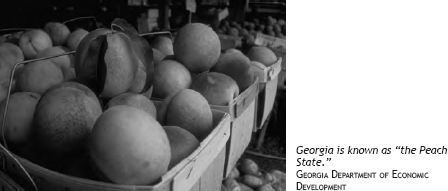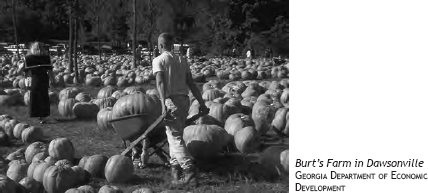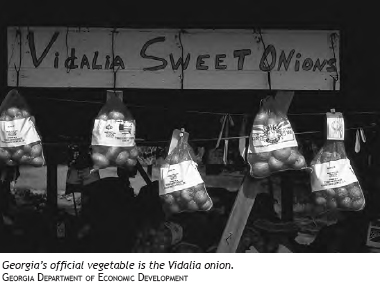
It’s not true that all Georgians drink Coca-Cola for breakfast, but we do consume a lot of the bubbly beverage invented by Atlanta pharmacist John Pemberton in the late 19th century.
Coke is the biggest soft drink company in Georgia, but it’s not the only one. Another famous beverage is RC (or Royal Crown) Cola, concocted in Columbus in 1905 by Claude A. Hatcher. RC became known as the beverage of choice when you’re eating a MoonPie—a ubiquitous Southern snack that consists of two large cookies with a marshmallow filling. Hatcher’s company introduced fruit-flavored soft drinks called Nehi in 1924.
Some die-hard Coca-Cola lovers still buy the drink in glass bottles. If you want to appear to be a longtime Georgian, take a pack of salted peanuts and pour it into the Coke bottle before you drink. Purists use only peanuts from Tom’s, a Columbus company that specializes in peanuts, crackers, and other snack foods.
What else do Georgians eat? Well, grits, of course, preferably stone-ground and seasoned with salt, pepper, butter, or red-eye gravy made from country ham. Only Yankees or lazy Southerners eat instant grits, and no true Southerner puts sugar on them. In 2002, the Georgia legislature proclaimed grits the state’s “official prepared food.” Grits also are tasty cooked with shrimp (one of Georgia’s most prized seafood crops) or served with fried catfish.
Georgians love barbecue, too, though we’re not as fanatical about it as North Carolinians. Most of our barbecued pork is flavored with tomato-based sauces. To try a sample of the different kinds of barbecue, check out the Slosheye Trail Big Pig Jig. Held every fall in Vienna, this cookoff is considered one of the top barbecue contests in the country.
We are even fussier about Brunswick stew. Georgians have long engaged in a war of words with Virginians, who claim to have invented the delicacy and ignore the fact that it obviously was named after the Georgia city of Brunswick. Virginians prefer chicken as the main meat ingredient; Georgians like pork and beef. Recipes vary but usually include tomatoes, lima beans, corn, chicken, pork, and beef. Some folks substitute squirrel, rabbit, or venison, but whatever ingredients you throw in the pot, make sure the stew is thick and hearty. Otherwise, it’s just soup.
Since Georgia is known as “the Peach State,” it will come as no surprise that we consume peaches in great quantities. The same goes for peanuts, one of the state’s major crops. If you’ve moved here from somewhere north or west of the Mason-Dixon line, you may be unfamiliar with boiled peanuts. Boiled peanuts are cooked in the shell in salted water until tender. Black iron pots of boiled peanuts are a common sight at roadside stands in the fall.

Visiting these roadside stands and some of the larger farmers’ markets in Georgia is a good way to become acquainted with the variety of the state’s produce. The Atlanta State Farmers Market in Forest Park south of the city is a hub of activity during spring, summer, and fall. Many farmers sell pick-your-own strawberries and other fruits in season. Kauffman’s Farmarket in Montezuma offers strawberries and other vegetables, and Taylor Orchards in Reynolds sells peaches and strawberries. Up in North Georgia near Alto, Jaemor Farms offers fresh seasonal fruits and vegetables, as well as pickles and preserves.

When the frost is on the pumpkin, you can find the traditional Halloween fruit at Burt’s Farm in Dawsonville, Grandpa Jones Corn Maze and Pumpkins in Ellijay, any farmers’ market, and most roadside stands. This is the season when the owners of apple orchards in North Georgia bring out their harvests, along with cider, jellies, and fried apple pies. Hillcrest Orchards and Panorama Orchards in Ellijay offer apples, sorghum syrup, and other delicacies for sale; they also feature seasonal self-picking. Mercier Orchards in Blue Ridge begins picking apples in September.

If you belong to that unique group that loves fruitcake, you can find enough for the entire extended family at Claxton, “the Fruitcake Capital of the World.” The Trappist monks at the Monastery of the Holy Spirit in Conyers also make fruitcakes, fudge, and other baked goods for sale.

Georgia’s official vegetable is the Vidalia onion, a sweet onion first grown near Vidalia in the early 1930s. Vidalia onions are now protected by trademark. The name can be used to market onions grown only in a designated area in South Georgia.
Vidalia onions are delicious fried or chopped up with Hoppin’ John, another favorite dish of Georgians and most Southerners. Hoppin’ John is black-eyed peas and rice cooked with a chunk of ham, bacon, or hog jowl. Hoppin’ John and collard greens are a traditional New Year’s Day meal, said to bring good luck (and money) the rest of the year. Maybe it does for the farmers who sell the peas and collards. By the way, you can find peas for Hoppin’ John, butterbeans (lima beans), tomatoes, and other vegetables at Calhoun Produce in Ashburn.
Georgia also produces dairy products and cheese. Sweet Grass Dairy in Thomasville and Flat Creek Lodge in Swainsboro are well known for their gourmet cheeses.
Tastes are different along the Georgia coast, where seafood and the Gullah cuisine are plentiful. The Gullahs, or Geechees, live on the barrier islands and are known for their unique seafood and rice dishes.
Fried chicken, fried pork chops, fried seafood, and fried green tomatoes are still regular items on many menus in Georgia, despite increased awareness of cholesterol problems and the emergence of “New South” chefs who serve gourmet—and healthier—versions of traditional Southern dishes.
A Peanut Primer

If you’re going to be a true Georgian, you have to learn the proper way to eat peanuts. I know, you’ve probably been eating roasted peanuts at baseball games all your life. Well, we eat roasted peanuts in the shell in Georgia, but we also eat them unshelled and salted, and we especially eat boiled peanuts. Here are a few tips on the cooking and consumption of “goober peas.”
First of all, we like salted peanuts in those little cellophane packets. Old-time Southerners rip the top off the packet and pour the salted peanuts into a bottle of Coca-Cola (the seven-ounce size) or Royal Crown Cola. Then they drink the beverage quickly, before the peanuts get soggy.
Misguided individuals may suggest dropping boiled peanuts into a bottle of Coke or RC. That may work for some, but it’s just not what most people in Georgia do. Stick with roasted peanuts if you’re going to dunk them in your favorite bottled beverage.
Boiled peanuts are the ocial snack food of South Carolina, but that doesn’t keep Georgians (and tourists) from consuming great quantities of them. Boiled peanuts are prepared by taking a fresh crop of just-picked green peanuts (they aren’t colored green, they’re pink and moist) and dropping them unshelled into a pot of salted water. Usually about a cup of salt for every two pounds of peanuts is adequate. Add enough water to cover the peanuts completely. Cook them for at least an hour, maybe two, then check a couple of the peanuts to see if they’re soft. If they’re crunchy, cook them longer. If they aren’t salty enough, let them sit in the salted water for several hours. A word of caution: don’t use peanuts that are mature or dry. They won’t be as tasty. And make sure you store boiled peanuts in the refrigerator or they’ll get slimy overnight.
If this sounds like too much trouble, just wait until early fall and take a trip to the mountains or to peanut country in South Georgia. There, you’ll find roadside stands with bubbling pots of boiled peanuts for sale. They may or may not taste as good as the ones you cook at home, but that’s the price you pay for being lazy.
If one Georgian can be credited—or blamed—for popularizing Southern food, it’s Paula Deen, the star of a cooking show on the Food Network. Deen, who began her culinary career by selling bag lunches in Savannah, now owns The Lady & Sons restaurant. She is the author of several best-selling cookbooks and even has her own magazine.
And let’s not forget the chili dog. Famous Georgia humorist and syndicated columnist Lewis Grizzard offered a tribute to the delicacy in his book Chili Dogs Always Bark at Night. While some purists may argue that the hot dog is not really a traditional Southern food, it is clear to most Georgians that it is as Southern as grits and sausage gravy. I’m not talking about the Coney Island dog or the Chicago dog with sauerkraut and other condiments. I’m talking about the kind of chili dog you find in country stores, pool halls, and The Varsity.
Billed as “the World’s Largest Drive-In,” The Varsity in Atlanta was founded more than 75 years ago by Georgia Tech dropout Frank Gordy. The restaurant has curb-hops and sit-down dining and a menu of chili dogs, chili cheeseburgers, French fries, and fried onion rings, guaranteed to boost anyone’s cholesterol. The Varsity has expanded from its original location next to the Georgia Tech campus to open restaurants in Gwinnett County, Cobb County, and Athens.
Taking to heart Scarlett O’Hara’s postwar vow of never going hungry again, Georgians have launched a number of food companies to make sure they don’t. Here is a little information about the companies that provide breakfasts, lunches, dinners, desserts, and bubbly refreshments.
The Coca-Cola Company Atlanta and Coca-Cola go hand in hand like, well, Coca-Cola and salted peanuts. Not long after John Pemberton served the first glass of his new concoction at Jacobs’ Pharmacy in 1876, Coca-Cola became a local and regional favorite. Robert W. Woodruff, who became president of the company in 1923, took Coke to international markets. At the beginning of World War II, he promised to provide a Coke for a nickel to every American serviceman. This patriotic gesture resulted in the building of bottling plants around the world and made Coca-Cola a symbol of America.
Royal Crown Cola Company Royal Crown (RC) never overtook Coca-Cola’s lead as the most popular soft drink in the world, but it did become a memorable part of Southern culture. Even today, some people insist on having an RC and a MoonPie at least once a week. There’s even a famous country song called “RC Cola and Moon Pie.” Based in Columbus, Royal Crown was the first in the soft-drink industry to introduce a diet cola, a caffeine-free diet cola, and aluminum cans. In 2000, the British company Cadbury Schweppes bought RC Cola.
Tom’s Foods What would a Coke or an RC be without salted peanuts or peanut butter and cheese crackers? A few decades after soft drinks became a daily treat for Georgians, the Tom Huston Peanut Company began selling individual packages of roasted peanuts. In 1926, John Thomas “Tom” Huston of Columbus trademarked the familiar package with its red triangular logo. The company changed hands several times and was bought by General Mills in 1966. In 1970, the company became Tom’s Foods. Lance, Inc., bought the company in 2005. Tom’s now makes pretzels, potato chips, cookies, pastries, and candy bars, but roasted peanuts are still its best seller.
Stuckey’s If you’ve ever driven through Georgia on the way to or from Florida, chances are you’ve stopped at a Stuckey’s. The company began when Williamson S. Stuckey, Sr., of Eastman set up a roadside stand on Ga. 23 to sell his pecans. Nut sales were so successful that he added his wife’s homemade pecan candies. The Stuckey’s Pecan Log Roll, made of roasted nuts, white molasses, and sugar, became its trademark product. As business increased, the company added a restaurant and souvenir shop. Today, Stuckey’s has become a Southern roadside icon, boasting more than 200 stores in 19 states.
Chick-fil-A Since Chick-fil-A has restaurants in 38 states, you’ve probably enjoyed one of its chicken sandwiches. Now that you’re in Georgia, you can see where it all began. Founder Truett Cathy started the business at the Dwarf Grill in Hapeville by developing a pressure-cooked, fried, boneless chicken breast sandwich. As the company grew, it expanded the menu to include grilled chicken sandwiches, chicken salad, and chicken wraps. A major reason for the company’s growth, besides the delicious food, is a national marketing campaign using cows on billboards and in TV ads urging people to “Eat Mor Chikin.” As a result, Chick-fil-A has reported sales of more than $1.75 billion annually and employs more than 46,000 people. It is the second-largest fast-food chicken restaurant in the country.
Waffle House The bright yellow signs of this restaurant chain are as familiar in Georgia—and the rest of the nation—as McDonald’s golden arches. Among family-style eateries, only Denny’s is larger than this restaurant that offers breakfasts (waffles and eggs, of course), T-bone steaks, sandwiches, and other items 24 hours a day, 365 days a year. DeKalb County neighbors Joe Rogers and Tom Forkner launched Waffle House in 1955. One of its specialties, besides waffles, is hash brown potatoes prepared in different ways—scattered (plain), smothered (with onions), or covered (with cheese). Or you can get them smothered and covered. Waffle House has become a Southern cultural icon. In 2000, the rock band Hootie and the Blowfish released a CD entitled, “Scattered, Smothered and Covered,” with a picture of a Waffle House on the cover. Atlanta’s Jeff Foxworthy and his fellow Blue Collar Comedy Tour comedians performed one of their skits while sitting in a Waffle House.
Huddle House Founded in DeKalb County in 1964 by John Sparks, Huddle House now has 400 restaurants in 14 states. Like its competitor Waffle House, Huddle House serves breakfasts and other meals 24 hours a day, 365 days a year. Menu items include butterfly shrimp, chicken wings, and sandwiches.
The best way to become acquainted with Georgia food is to sample lots of it. And the best way to do that, other than eating at every mom-and-pop restaurant in the state, is to attend some of the following food festivals:
International Chili Society’s Georgia State Cookoff, Rocco’s Pub, Marietta (spring)
National Grits Festival, Warwick (spring)
Vidalia Onion Festival, Vidalia (spring)
Georgia Blueberry Festival, Alma (June)
Georgia Sea Island Festival, St. Simons Island (June)
Georgia Peach Festival, Peach County (June)
Watermelon Days Festival, Cordele (June)
Georgia Barbecue Classic, Cartersville (June)
Dillard Bluegrass & Barbecue Festival, Dillard (August)
BBQ, Blues & Bluegrass Festival, Decatur (August)
Tom Watson Watermelon Festival, Thomson (August)
Annual Labor Day Catfish Festival, Kingsland
Shrimp & Grits: The Wild Georgia Shrimp Festival, Jekyll Island (September)
The Great Miller Lite Chili Cookoff, Stone Mountain Park (September)
Apple Festival, Ellijay (October)
Cherokee Pignic, Canton (October)
Sorghum Festival, Blairsville (October)
Slosheye Trail Big Pig Jig, Vienna (fall)
Plains Peanut Festival, Plains (fall)
Savannah Seafood Festival, Savannah (November)
National BBQ Festival, Douglas (November)
Newcomers may be surprised to learn that Georgia is part of the winery renaissance sweeping the country. In 1900, Georgia was ranked sixth among grape-growing states. That was before Prohibition laws put an end to winemaking; Georgia banned alcoholic beverages in 1907. Eight decades later, farm bills were passed allowing winemaking to resume. Now, wineries are located all over northeastern Georgia.
Château Elan in Braselton is probably the best known because of the impressive 16th-century-style French château that houses the winery, restaurants, and a gift shop. Adjoining the château is a four-star hotel with more restaurants and a spa.
The mountain town of Dahlonega is home to four wineries: Montaluce Winery and Vineyards, Frogtown Cellars, BlackStock Vineyards, and Wolf Mountain Vineyards. Other wineries include Persimmon Creek Vineyards in Clayton, Sharp Mountain Vineyard in Jasper, Tiger Mountain Vineyards in Tiger, Habersham Winery in Helen, and Crane Creek Vineyards in Young Harris.
For more information about the wineries and a calendar of tasting events, visit www.georgiawine.com, the website of the Winegrowers Association of Georgia.
BOOKS AND RESOURCES
Brown, Fred, and Sherri M. L. Smith. The Best of Georgia Farms: A Cookbook and Tour Book. CI Publishing, 1998.
Dabney, Joseph Earl. Smokehouse Hams, Spoon Bread & Scuppernong Wine: The Folklore of Southern Appalachian Cooking. Nashville, Tenn.: Cumberland House, 1998.
Edge, John T. A Gracious Plenty: Recipes and Recollections from the American South. New York: Putnam, 1999.
Lewis, Edna, and Scott Peacock. The Gift of Southern Cooking. New York: Knopf, 2003.
New Georgia Encyclopedia. www.georgiaencyclopedia.org.